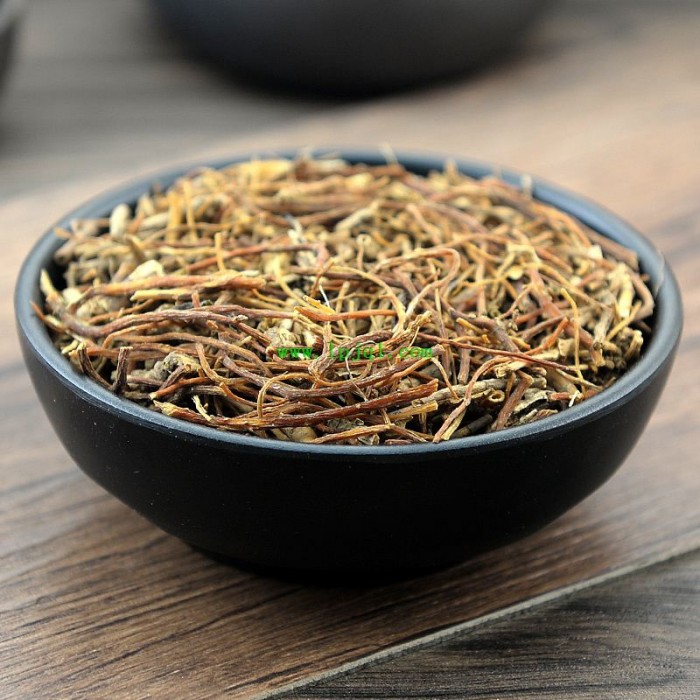Availability: In Stock
Ex Tax: $42.00
English name: RADIX GENTIANAE
Aliases: gentian, bitter bile grass, bile grass
The source of this product is: the dried roots and rhizomes of Gentiana manshurica Kitag., Gentiana scabra Bunge, Gentiana triflora pall or Gentiana rigescens Franch. The first three are called "gentian", the latter are called "firm gentian". Excavate in spring and autumn, wash and dry.
Characters Gentian: The rhizome is irregular, 1~3cm long and 0.3~1cm in diameter; the surface is dark gray or dark brown, with stem marks or residual stem base on the upper end, and many slender stems grow around and on the lower end. root. The root is cylindrical, slightly twisted, with a length of 10-20cm and a diameter of 0.2-0.5cm. The surface is light yellow or yellow-brown, with obvious horizontal wrinkles on the upper part and finer vertical wrinkles and root marks on the lower part. The texture is brittle, easy to break, the section is slightly flat, the skin is yellow-white or light yellow-brown, and the wood is lighter in color, showing dot-like rings. Smell and bitter.
Gentiana: There are no horizontal wrinkles on the surface, the outer skin is membranous, easy to fall off, the wood part is yellow and white, and it is easy to separate from the skin.
Identification:
(1) Cross section of this product: The epidermal cells of gentian sometimes remain, and the outer wall is thick. The cortex is narrow; the cells in the outer cortex are square-like, with slightly thicker walls and cork-like; the cells in the endothelial layer are elongated tangentially, and each cell is divided into several square-like small cells by the longitudinal wall. The phloem is broad and cracked. The cambium is not very obvious. Xylem ducts are 3 to 10 clusters. The pith is obvious. Parenchyma cells contain tiny calcium oxalate needle crystals.
Gentiana hardcorea Most of the tissues outside the endothelial layer have fallen off. The xylem ducts are well developed and densely distributed. No pith.
The powder is yellowish brown. The surface of the cells in the outer skin of gentian is fusiform, and each cell is divided into several small oblate cells by the transverse wall. The surface of the endothelial cells is rectangular and very large, with a slender horizontal texture in the peripheral wall view. Each cell is divided into several palisade-shaped cells by the mediastinum wall, and the mediastinum wall is mostly thickened in beads. Parenchyma cells contain tiny calcium oxalate needle crystals. The diameter of the reticulated and trapezoidal ducts is about 45μm.
Gentiana has no outer cortex cells. The endothelial cells are square-like or rectangular-like, and the horizontal texture of the flat peripheral wall is thick and dense, and some are as thick as 3μm. Each cell is divided into many grid-like small cells, and the partition wall is slightly thickened or in a bead-like shape.
(2) Take 0.5g of this product powder, add 5ml methanol, soak for 4 to 5 hours, filter, and concentrate the filtrate to about 2ml as the test solution. Take another gentiopicroside reference substance, add methanol to make a solution containing 2mg per 1ml, as the reference substance solution. According to the test of thin layer chromatography (Appendix VI B), draw 5μl of each of the above two solutions, and place them on the same silica gel GF254 thin-layer plate with sodium carboxymethyl cellulose as the binder, and add ethyl acetate-methanol-water (20:2:1) is a developing agent, unfold it for the second time, take it out, dry it, and inspect it under an ultraviolet light (254nm). In the chromatogram of the test substance, spots of the same color appear on the position corresponding to the chromatogram of the reference substance.
Process to remove impurities, wash, moisturize, cut into sections, and dry.
Nature and taste are bitter, cold.
Return meridian: return liver and gall bladder meridian.
Functions and indications: clearing away heat and dampness, reducing liver and gallbladder fire. Used for damp-heat jaundice, yin swelling and itching, vaginal discharge, strong middle, eczema and itching, red eyes, deafness, hypochondriac pain, pain in the mouth, convulsions and convulsions.
Usage and dosage 3~6g.
Store in a dry place.
Remarks:
(1) When used with Bupleurum, Shanzhi, and Scutellaria, it will clear the liver and reduce the fire; when it is used with Mutong, Plantago, Alisma, it will relieve dampness and heat; when it is mixed with Coptis, Bezoar, and Uncaria, it will reduce the fire and relieve the fire. ; With Yinchen, turmeric, phellodendron, it will promote dampness and reduce yellowing.
Excerpt from "National Compilation of Chinese Herbal Medicine"
Buy before reading:
★ picture only for reference to the kind of delivery subject. Because the herbs are different from other commodities, each batch of goods fineness is not exactly the same, we can do is choose a good quality of delivery, this please rest assured!
Disclaimer
All testimonies found on this website are 100% genuine. Actual
results may vary per individual, and should be used
inconjunction with a proper nutritionally balanced diet plan and
exercise regime. The statements made on our websites
have not been evaluated by the MHRA or FDA (U.S. Food & Drug
Administration). These products are not intended
to diagnose,cure or prevent any disease. You should consult with a
healthcare professional before starting any diet,
exercise or supplementation program, before taking any medication,
or if you have or suspect you might have a health
problem. Our dietary supplements are not recommended for persons
under the age of 18 unless recommended by a GP.
| Product basic attributes | |
| Shelf Life: | 365 days |
| Storage: | Dry storage, low temperature refrigeration |
| Organic or inorganic | organic |




